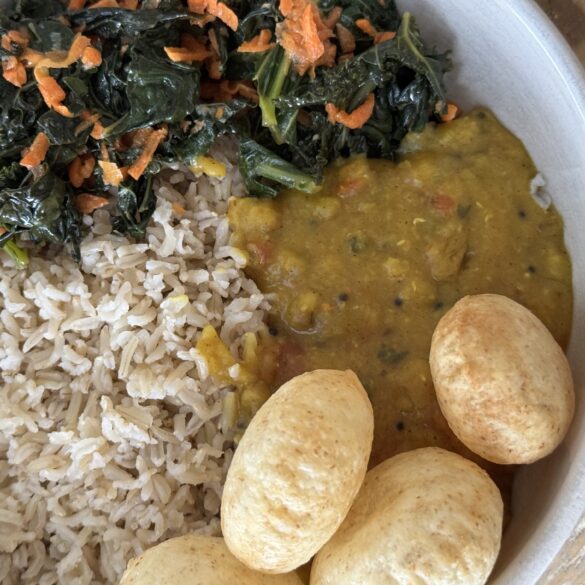When I was in graduate school, cooking Indian food not only improved my diet, but it saved me money. I learned how to cook Indian food from my aunt-in-law in India. My husband Is from India. This was a time before easy access to recipes and ingredients online. My aunt taught me the basics. She made magic in her kitchen. I didn’t see bottles of pre-made sauce or canned goods. But what they had a lot of was dried lentils, ground spices, grains, nuts, seeds, whole wheat flour, and fresh veggies they bought weekly.
A pressure cooker was also a staple in the home. This masoor dal curry bowl recipe makes use of an Instant Pot. Technically, you can make it without a pressure cooker, but it will take longer. I have the instructions towards the end of the article,
The Indian Diet
I’ve always wondered why we celebrate Mediterranean food, but overlook Indian cuisine when it comes to health. I understand that Indian cuisine is regional, much like the the Mediterranean diet. North India is known for creamier and richer dishes. On the other hand, South India uses more lentils and coconuts. Health related criticisms online of Indian food usually refer to the use of ghee and food rich in carbohydrates, such as rice and bread. But have you seen the way focaccia bread is made? I think one reason why we overlook Indian food as part of having a healthy diet is that India is still relatively a poor country. We tend to measure a cuisine’s healthiness based on life expectancy, so as a result, income and overall economy are confounding variables.
Indian cuisine uses lentils, legumes, herbs and spices, and fresh veggies. In a time when we are talking about the importance of gut health, plant-based protein, and avoiding ultra-processed food, Indian dishes have a lot to offer. The key, like most healthy diets, is to cook more at home. I know that some Indian restaurants in my area add food coloring and some dishes can get oily.
The Masoor Dal Fusion Bowl
The bowl combination I have in the picture makes use of traditional Indian ingredients, pani puri, in a non-traditional manner. Pani puri is a snack, but I love to add it to my lentil dishes. I also added a fusion ingredient, kale-carrot miso as a side dish. Because one of the perks of being connected to the world is that we learn from other cultures and we can buy ingredients more easily now.
Np Pressure Cooker, No Problem
If you don’t have a pressure cooker, simply wash and soak the masoor dal and mung beans for at least 1 hour. The pressure cooker recipe calls for 3 cups of water. Drain the beans and add 5 cups of water. Boil with a covered lid. Keep checking to make sure that you have enough water and iff you need more. Lentils and beans should be soft.

